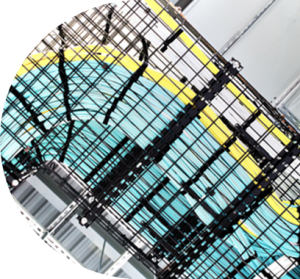
Recent advancement in Gigabit Ethernet technology, specifically 25-Gbps speed technology for Top-of-the-Rack (ToR) server interfaces, is prompting such a shift. As discussed in this document, 25 Gigabit Ethernet ports now are poised to become the most prevalent data center server access ports in next five years.
- What is really causing this transition and why are people excited about it?
- How does it affect your data center strategy?
- Is there a seamless migration path? How will your existing cabling infrastructure be affected? How much will it cost?
- Will the price-to-performance ratio justify your new investment?
- What is Cisco’s strategy for the future?
You need answers to these questions before you move to 25-Gbps technology.
Why now?
In today’s application-based world, business continuity is paramount. Customers demand applications 24 hours a day, every day. Virtualization is the new “legacy” technology. Big data is more mainstream than ever before. Applications continue to become more distributed by the minute. A multicloud data center strategy is no longer just good to have—it’s essential. And with these advancements, applications are more demanding than ever. Your network needs to keep up.
Today, background tasks such as application and network snapshot processes, application backup operations, workload migration for high availability, and load balancing add substantial traffic. The distributed nature of modern applications has caused an increase in this background traffic, in addition to the traffic traversing the network fabric. Advancements in the server technology have made servers better and faster. They can easily keep up as the industry migrates to 100-Gbps spine switches.
Therefore, the challenge is to help ensure that server leaf Ethernet downlink connections do not become bottlenecks when spine switches migrate to 100 Gbps.
 The big challenge
The big challenge
Capital Expenditures (CapEx) are one of the biggest considerations in the adoption of any new data center technology. The one aspect that most concerns data center operators is cabling. Some consider cabling to be the most cumbersome and riskiest part of data center management. Most operators prefer to install cables once and never touch them again. 25 Gigabit Ethernet allows seamless migration from 10 Gigabit Ethernet without the need to touch those cables.
Most 10-Gbps data centers use Small Form-Factor Pluggable (SFP) optical transceivers. For those considering an upgrade to 25 Gbps, the good news is that the fiber that is already installed will most likely continue to work with the new speeds. You will only need to upgrade the optical transceivers to support the faster, 25-Gbps speed.
The case for 25 Gigabit Ethernet
Until recently, as shown in Table 1, 10 Gbps has been the building block for all the higher Ethernet speeds. The fundamental building block was the Serializer and Deserializer (SerDes) that operated with a clock speed of about 12.5 GHz, providing the 10-Gbps transfer rate. For example, a 40 Gigabit Ethernet interface is constructed of 4 parallel SerDes links. Similarly, 100 Gigabit Ethernet interfaces were initially constructed out of 10 parallel paths of 10-Gbps streams.
The Ethernet industry continues to innovate and push the boundaries beyond 100 Gigabit Ethernet. 25 Gigabit Ethernet was developed to provide a simpler and more cost-efficient path to future Ethernet speeds, including 50 Gbps, 100 Gbps, and beyond.
Table 1
| Port speed (Gbps) | Lane speed (Gbps) | Lanes per port |
| 10 (current) | 10 | 1 |
| 40 (current) | 10 | 4 |
| 25 (new) | 25 | 1 |
| 40 (new) | 20 | 2 |
| 100 (new) | 25 | 4 |
Ethernet Speeds
In the past several years, rapid technology advancements have made 25-GHz SerDes links economically viable. As of June 2016, 25 Gigabit Ethernet equipment is available on the market using the SFP28 and Quad SFP28 (QSFP28) transceiver form factors.
Thus, data can now be pushed across the serial links 2.5 times as fast as across 10-Gbps interfaces based on the 12.5-GHz clock speed. The new 25 Gigabit Ethernet ports can still support 10 Gigabit Ethernet, but they would not use all the capacity of that connection.
40 Gigabit Ethernet will then include two parallel 25-GHz SerDes links, rather than the four required today. Similarly, 100 Gigabit Ethernet will quickly move away from the current 10-lane implementations to four 25-Gbps lanes. These reduced space requirements ultimately translates into less cabling between devices, leading to greater efficiency at lower cost: a win-win situation.
Cisco Nexus 93180YC-EX Switch

The Cisco Advantage
Switches ready to support 25 and 50 Gigabit Ethernet have been a main focus in the development of next-generation Cisco Nexus® switches.
The launch of the Cisco Nexus 93180YC-EX Switch, the industry’s first 25-Gbps-capable 1-Rack-Unit (1RU) switch, underscores that focus. What makes this achievement especially significant is the fact that the 93180YC-EX was built using the home-grown Cisco® Cloud Scale Application-Specific Integrated Circuit (ASIC) leveraging 16-nanomet (nm) technology. Since then, Cisco has aggressively continued to build its 25 and 50 Gigabit Ethernet switch portfolio.
The new Cisco Nexus 93180YC-FX Switch supports the full IEEE requirements for 25 Gigabit Ethernet. The advancements in 16-nm technology have enabled Cisco to differentiate itself from its competitors. By adding flow tables, unified ports, congestion control, and other features to its chips, Cisco can offer more to customers at an affordable price.
At the same time, Cisco realizes that many customers have standardized their architectures on merchant silicon, including Trident and Tomahawk chip sets from Broadcom. A subset of the Cisco Nexus Family switches, including Cisco Nexus 3000 Series Switches, continue to support these merchant-silicon ASICs.
Note that two different 25 Gigabit Ethernet standards were developed in parallel: 25-Gbps connectivity between the server and the ToR switch within the rack, and 25-Gbps connectivity across racks and between switches. Cisco is leading and actively participating in efforts both to standardize 25 Gigabit Ethernet and bring it to market.
All Cisco Nexus 9200, 9300 EX, and 9500 platform switches based on Cisco Cloud Scale technology comply with the 25 Gigabit Ethernet consortium specifications.
Table 2
| Cisco Nexus 92160YC-X | Cisco Nexus 9236C | Cisco Nexus 92300YC | |
| Use | Top of rack | Access and aggregation | Access |
| 25 Gigabit Ethernet ports | 56 | 144 | 48 |
Cisco Nexus 9200 Series Switches (built with Cisco Cloud Scale ASIC; support only NX-OS mode)
Download: Cisco Nexus 9200 Switch Data Sheet
Table 3
| Cisco Nexus 93180YC-EX | Cisco Nexus 93180YC-FX | |
| Use | Cisco ACI leaf switch, ToR switch, and fabric extender aggregation, powered by Cisco Cloud Scale technology | Cisco ACI leaf switch, ToR switch, and fabric extender aggregation, powered by Cisco Cloud Scale technology |
| 1/10/25 Gigabit Ethernet fiber ports | 48 x 1/10/25 Gigabit Ethernet | 48 x 1/10/25 Gigabit Ethernet |
Cisco Nexus 9300 Series spine and leaf switches (support both NX-OS and ACI modes)
Download: Cisco Nexus 9300 Switch Data Sheet
Cisco Nexus 9300-EX Switch Data Sheet
Table 4
| Cisco Nexus 3232C | Cisco Nexus C36180YC-R | |
| ToR and end of row (EoR) | Aggregation | |
| Maximum 25 Gigabit Ethernet ports | 128 | 48 |
Cisco Nexus 3000 Series Switches (support NX-OS mode; built with merchant silicon)
More Guides to Download: Guide to Upgrade Cisco Access and Backbone Switch
Selecting Cisco Switches-Campus, Branch, Digital Building
Select and Upgrade Cisco Data Center Switch
The 25-Gbps Cisco portfolio
As one of the key members of the 25 Gigabit Ethernet consortium, Cisco is fully committed to the success of the 25 and 50 Gigabit Ethernet standards. Cisco offers a wide range of 25 Gigabit Ethernet–ready switches for both Cisco NX-OS Software (NX-OS mode) and Cisco Application Centric Infrastructure (Cisco ACI™; ACI mode) in versions for Cisco Cloud Scale and third-party ASICs (Tables 2, 3, and 4).
The case for upgrading to 25 Gigabit Ethernet, with its superior price-to-performance ratio and low infrastructure CapEx requirements, is compelling. The question is not why upgrade but when. The future of Ethernet is here, and Cisco is there for you. What are you waiting for?
More Related:
Features and Benefits of Cisco 25G, QSFP and QSFP28 Modules
Cisco 25G Transceivers for Next Generation Switches
Cisco 25-Gigabit Ethernet Transceiver Modules for Nexus 9000 & Nexus 3000


